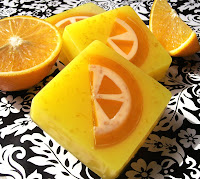Here is a breakdown of the ingredients used in the aforementioned Dove soap. Source: "A Consumer's Dictionary of Cosmetic Ingredients" by Ruth Winter.
Sodium Lauryl Isethionate, synonymous with Sodium Lauryl Sulfate. According to DCI it is used as a detergent, wetting agent, and emulsifier. It may dry the skin out because of it's degreasing properties. Depending on where you look, this detergent is either listed as a mild or potent skin irritant. I never use SLS in my soap.
Stearic Acid Used as a hardener in soap. Stearic acid is prepared by treating animal fat with water at a high pressure and temperature, leading to the hydrolysis of triglycerides.
Sodium Tallowate Used for cleansing, Sodium tallowate is a substance extracted from the fatty deposits of animals, especially from suet (the fat of cattle and sheep). In my soaps I use vegetarian alternatives to tallow (such as olive oil) that work as well or better.
Sodium Palmitate Used for cleansing and creating lather. Sodium Palmitate is a salt of Palmitic Acid made my mixing Palmitic Acid with Lye. This ingredient cleanses your skin, but may dry it out.
Lauric Acid Occurs naturally in some vegetable oils like palm oil. It can be irritating to super-sensitive individuals at high concentrations. This ingredient cleanses your skin.
Sodium Isethionate Saponification agent (this is what turns the oils into soap). Synonyms include Sodium Hydroxide or Lye. Occurs naturally in wood ash. ALL soap requires an oxidizer such as Sodium Isethionate.
Water Typically used in soap as a solvent for dissolving the oxidizer.
Sodium Stearate The Stearate salts are generally used for their lubricating properties. They also help to keep emulsions from separating into their oil and liquid components. Made by reacting sodium with stearic acid to create the salt, sodium stearate. This ingredient does not appear to have any beneficial properties for your skin.
Cocamidopropyl Betaine is a synthetic surfactant derived from coconut oil and dimethylaminopropylamine.
Sodium Cocoate This is a gentle surfactant. Sodium cocoate is produced by hydrolysis of the ester linkages in coconut oil with sodium hydroxide (same as Sodium Isethionate).
Sodium Palm Kernelate This is a gentle surfactant. How It's Made: Sodium Palm Kernelate is formed by combining Palm Kernel oil with an oxidizer (such as Sodium Hydroxide).
Sodium Chloride Used as a thickening agent. Sodium Chloride is the same as ordinary table salt.
Tetrasodium EDTA Used as a preservative and chelating agent. About This Ingredient: No known toxicity to the skin. Synthesized in a lab.
Tetrasodium Etidronate Used as a preservative and chelating agent. A synonym for Tetrasodium EDTA.
Maltol Used as a flavor enhancing agent. It might be used as a fragrance, although Dove claims this bar to be unscented.
Titanium Dioxide Used as a whitening agent, titanium dioxide is the naturally occurring oxide of titanium. About Titanium Dioxide is thought to have no negative side effects when used externally.
The ingredients in handmade soap are better for your skin, and better for the environment! Por ejemplo, here's the list of ingredients in an Epically Epic Mimosa Soap:
 100% VEGAN INGREDIENTS Olive Oil, Palm Oil, Castor Oil, Safflower Oil, Glycerin (kosher, of vegetable origin), Purified Water, Coconut Oil, Shea Butter, Sodium Hydroxide (saponifying agent), Sorbitol (moisturizer derived from berries), Sorbitan Oleate (emulsifier), Soybean Protein (conditioner), Essential Oils, Fragrance, Lemon Peel, Orange Peel, Oatmeal, Color.
100% VEGAN INGREDIENTS Olive Oil, Palm Oil, Castor Oil, Safflower Oil, Glycerin (kosher, of vegetable origin), Purified Water, Coconut Oil, Shea Butter, Sodium Hydroxide (saponifying agent), Sorbitol (moisturizer derived from berries), Sorbitan Oleate (emulsifier), Soybean Protein (conditioner), Essential Oils, Fragrance, Lemon Peel, Orange Peel, Oatmeal, Color.

No comments:
Post a Comment